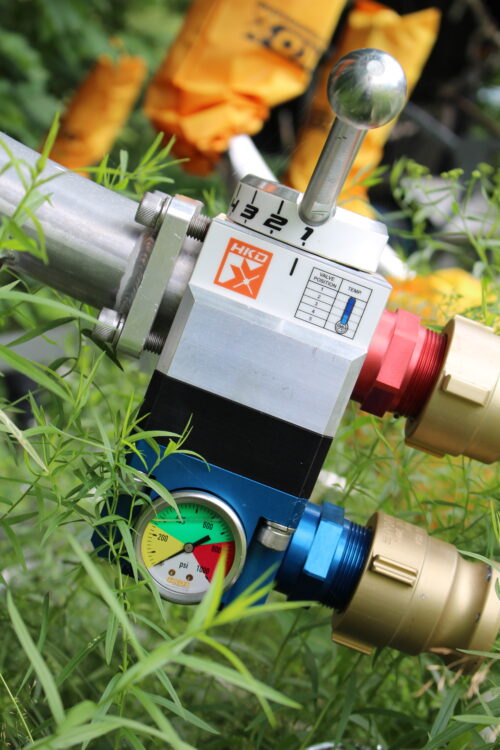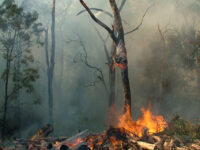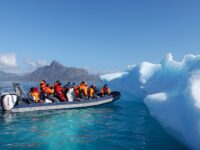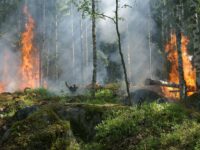Preparations for ski season start early in Vermont’s Green Mountains. In early October, Greg Gleason, who runs snowmaking at Killington Ski Resort, gives his staff the all-clear. Over the next four hours the system of artificial snow production on which Vermont’s tourism industry increasingly depends roars to life. Hundreds of thousands of gallons of water rush through miles of pipelines connecting the pump houses, 88 valve stations, and 5,000 hydrants. As more than 100 snow guns begin showering the mountain in snow, Killington quickly becomes the largest energy consumer in the area.
New England winters have warmed a blistering 4.5 degrees Fahrenheit in the past 50 years, faster than any other season, making the region the fastest-warming area in the United States. Warmer winters, obviously, produce less snow. In order to survive the uncertain climate, resorts have become increasingly reliant on fake snow. Now, over 90% of resorts have snowmaking systems, up from just over half in 1970, and many resorts, like Loon in New Hampshire, have more than doubled their snowmaking capabilities in the past two decades. To the great fortune of ski resorts from Stowe to St. Moritz, necessity is the mother of invention, and as global warming has accelerated, innovations in the snowmaking industry have kept pace.
“I’ve been doing this 18 years, and the technology has been changing at a rapid rate,” Gleason said.
Most of those rapid advancements, it turns out, have been made right here in the Greater Boston area, by way of one Natick-based company, HKD Snowmakers. HKD’s water hydrants can pump out three times more snow than traditional hydrants, and their guns’ energy efficiency has improved 10-fold since the 1990s. After installing HKD snow guns, Loon Mountain was able to increase snowmaking by 60% while decreasing its energy bill.
HKD’s snowmaking guns are used “all over the nation,” said Chris Stimpson, the Public Relations Manager at Wachusett Mountain Ski Area in Massachusetts. “They’re pretty much the leader in high-efficiency guns.”
“To the great fortune of ski resorts from Stowe to St. Moritz, necessity is the mother of invention, and as global warming has accelerated, innovations in the snowmaking industry have kept pace.”
While snow can stick around even in above-freezing temperatures, making it requires temperatures of around 4 to 10 degrees below freezing. In a 2018 study, Ken Mack, the head of snowmaking at Loon, teamed up with Geoffrey Wilson, a scientist at a nearby ecologically studied forest. They found that Loon has experienced a 10% decrease in the number of hours with good snowmaking weather in the last 50 years due to climate changes. Yet, the resort was able to increase its snow production rate by almost 60% between 2002 and 2014 alone.
Wachusett Mountain has noticed the decrease in hours with good snowmaking conditions, said Stimpson. “That’s why it’s so important to take advantage of the hours we have.”
“After installing HKD snow guns, Loon Mountain was able to increase snowmaking by 60% while decreasing its energy bill.”
December, the month of the year with the highest rates of visitation, has been warming even faster. In the 2016-2017 season, Loon sold over three times more tickets per day between Christmas and New Year’s Day than during the rest of the season, yet the month has lost a fourth of its viable snowmaking time in the past half-century. And resorts’ snowmaking operations have to rely on the warmer months of October and November to cover the grassy slopes with a thick, solid base of snow before they can add a softer layer that resort-goers actually ski on. Because of this, Killington brings an additional 28 portable air compressors to its early-season snowmaking, and keeps half of those operational through December.
The HKD technology
HKD guns provide resorts with extreme flexibility with the type of snow they can make. Shift the valve to one end, and snowmaker machines can produce thick, wet base snow in warmer temperatures. At the other end, the gun can produce light and fluffy snow to resurface slopes that are already open in colder weather. With warmer and more variable winters, this flexibility for snowmakers is key.
“From the manufacturing standpoint, how we try to balance it is to give the snowmaker flexibility,” Mack said, who has since moved from Loon to working for HKD.
The HKD vision of snowmaking doesn’t stop at efficient guns. They’ve expanded into software and hardware tools to analyze and improve the efficiency of a resort’s entire snowmaking system, including water hydrants, fan snowmakers, and towers to elevate guns. This process is facilitated by iSNO, the computer software suite for automating and analyzing the whole process.
“The resort, engineering firm, or university can request that data, look through those reports, and find efficiencies or deficiencies in the operation,” Mack said. “That’s an incredible tool for resorts to really look at their operation and see, like, ‘Oh wow, we could do better.’”
Controller rooms will use iSNO to monitor the entire system. These systems use industrial-scale pumps to draw water from a reservoir such as a lake or river. Human-made reservoirs add an extra layer of flexibility for snowmakers. The system pumps water into the reservoir whenever natural water sources are plentiful, such as a high river because it rained upstream. Then, they can pump water out of the human reservoir when the weather is cold and conditions are right.
At the same, air compressors begin pressurizing air from the atmosphere. The pressurization process heats the gas to upward of 200 degrees, so the compressor house then needs to chill the air down to around 60 degrees with massive heat exchangers and remove any moisture, which could damage the snow guns.
Finally, the air and water are pumped up the mountains to the snow guns. The guns blast the air and water together, creating an energetic mist. Snowmakers adjust the water-to-air mix based on the temperatures and the type of snow they plan to make. Once the mist hits the below-freezing outside air, it almost instantaneously freezes, falling down to the ground as snow.
Compressing air is an energy-expensive process and often a bottleneck in the process since local utilities limit the amount of energy resorts can consume. HKD’s key innovation is specialized valves and nozzles that reduce the amount of compressed air needed. Old guns from the late ‘80s and early ‘90s would use somewhere between 300 and 400 cubic feet of air per minute. HKD has brought this down to between 30 and 120 cubic feet per minute — and down to 14 in certain applications.
“These days, 10 to 15 guns use about the same amount of compressed air as one old-school gun,” Stimpson said.
However, even as the energy demand of snowmaking decreases, the amount of water needed to make a set amount of snow remains constant: the snow has to come from somewhere. This has led to strains on local water sources and has forced ski areas to get creative.
Loon created a massive water reservoir that allows them to pump in and store water from the local river whenever it’s high. Wachusett draws water from a massive local natural reservoir to make snow, then at the end of the season, as the human-made snow melts, it runs down the slopes back into the same reservoir.
Killington, with a larger water supply than most resorts, hasn’t had to worry about the warming climate yet. Simply, “If it’s cold, we make snow,” Gleason said.
Action and advocacy
Yet some in the ski industry worry that a day may come when the warming is simply too great to put enough snow on the ground. It’s a possibility that motivates resorts to advocate for environmentally friendly and carbon-neutral practices, partly through leading by example.
“Yet some in the ski industry worry that a day may come when the warming is simply too great to put enough snow on the ground. It’s a possibility that motivates resorts to advocate for environmentally friendly and carbon-neutral practices”
“It’s definitely a concern. Resorts are making gains in efficiency to compensate for that, taking advantage of shorter windows,” Mack said. “But they’re also doing the right thing buying energy efficient equipment to lower their carbon footprint.”
Over 200 resorts, including Killington, Wachusett, and Loon, have endorsed the Sustainable Slopes initiative by the National Ski Areas Association, hosting members of Congress — from both parties — and advocating for environmentally conscious practices, the reduction of carbon emissions, and increased climate action within the ski industry.






